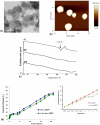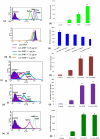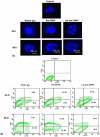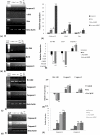Long circulating lectin conjugated paclitaxel loaded magnetic nanoparticles: a new theranostic avenue for leukemia therapy
- PMID: 22110595
- PMCID: PMC3217954
- DOI: 10.1371/journal.pone.0026803
Long circulating lectin conjugated paclitaxel loaded magnetic nanoparticles: a new theranostic avenue for leukemia therapy
Abstract
Amongst all leukemias, Bcr-Abl positive chronic myelogenous leukemia (CML) confers resistance to native drug due to multi drug resistance and also resistance to p53 and fas ligand pathways. In the present study, we have investigated the efficacy of microtubule stabilizing paclitaxel loaded magnetic nanoparticles (pac-MNPs) to ascertain its cytotoxic effect on Bcr-Abl positive K562 cells. For active targeted therapy, pac-MNPs were functionalized with lectin glycoprotein which resulted in higher cellular uptake and lower IC(50) value suggesting the efficacy of targeted delivery of paclitaxel. Both pac-MNPs and lectin conjugated pac-MNPs have a prolonged circulation time in serum suggesting increased bioavailability and therapeutics index of paclitaxel in vivo. Further, the molecular mechanism pertaining to pac-induced cytotoxicity was analyzed by studying the involvement of different apoptotic pathway proteins by immunoblotting and quantitative PCR. Our study revealed simultaneous activation of JNK pathway leading to Bcr-Abl instability and the extrinsic apoptotic pathway after pac-MNPs treatment in two Bcr-Abl positive cell lines. In addition, the MRI data suggested the potential application of MNPs as imaging agent. Thus our in vitro and in vivo results strongly suggested the pac-MNPs as a future prospective theranostic tool for leukemia therapy.
Conflict of interest statement
Figures











Similar articles
-
The transport of non-surfactant based paclitaxel loaded magnetic nanoparticles across the blood brain barrier in a rat model.Biomaterials. 2012 Apr;33(10):2936-51. doi: 10.1016/j.biomaterials.2011.12.046. Epub 2012 Jan 20. Biomaterials. 2012. PMID: 22264522
-
Transferrin-conjugated curcumin-loaded superparamagnetic iron oxide nanoparticles induce augmented cellular uptake and apoptosis in K562 cells.Acta Biomater. 2012 Feb;8(2):704-19. doi: 10.1016/j.actbio.2011.10.022. Epub 2011 Oct 22. Acta Biomater. 2012. Retraction in: Acta Biomater. 2013 Jun;9(6):7077. doi: 10.1016/j.actbio.2013.02.023. PMID: 22051236 Retracted.
-
Genomic mechanisms of p210BCR-ABL signaling: induction of heat shock protein 70 through the GATA response element confers resistance to paclitaxel-induced apoptosis.J Biol Chem. 2004 Aug 20;279(34):35604-15. doi: 10.1074/jbc.M401851200. Epub 2004 May 21. J Biol Chem. 2004. PMID: 15155749
-
Sustained targeting of Bcr-Abl + leukemia cells by synergistic action of dual drug loaded nanoparticles and its implication for leukemia therapy.Biomaterials. 2011 Aug;32(24):5643-62. doi: 10.1016/j.biomaterials.2011.04.043. Epub 2011 May 19. Biomaterials. 2011. PMID: 21600647
-
Lectins as the prominent potential to deliver bioactive metal nanoparticles by recognizing cell surface glycans.Heliyon. 2024 Apr 11;10(8):e29394. doi: 10.1016/j.heliyon.2024.e29394. eCollection 2024 Apr 30. Heliyon. 2024. PMID: 38638961 Free PMC article. Review.
Cited by
-
The impact of molecular tumor profiling on the design strategies for targeting myeloid leukemia and EGFR/CD44-positive solid tumors.Beilstein J Nanotechnol. 2021 Apr 29;12:375-401. doi: 10.3762/bjnano.12.31. eCollection 2021. Beilstein J Nanotechnol. 2021. PMID: 33981532 Free PMC article. Review.
-
MRI Contrast Agents in Glycobiology.Molecules. 2022 Nov 28;27(23):8297. doi: 10.3390/molecules27238297. Molecules. 2022. PMID: 36500389 Free PMC article. Review.
-
Intelligently targeted drug delivery and enhanced antitumor effect by gelatinase-responsive nanoparticles.PLoS One. 2013 Jul 30;8(7):e69643. doi: 10.1371/journal.pone.0069643. Print 2013. PLoS One. 2013. PMID: 23936062 Free PMC article.
-
Mogrol represents a novel leukemia therapeutic, via ERK and STAT3 inhibition.Am J Cancer Res. 2015 Mar 15;5(4):1308-18. eCollection 2015. Am J Cancer Res. 2015. PMID: 26101699 Free PMC article.
-
Zeptomole detection of DNA nanoparticles by single-molecule fluorescence with magnetic field-directed localization.Anal Biochem. 2012 Dec 1;431(1):40-7. doi: 10.1016/j.ab.2012.08.017. Epub 2012 Aug 26. Anal Biochem. 2012. PMID: 22929698 Free PMC article.
References
-
- Jacquel A, Herrant M, Legros L, Belhacene N, Luciano F, et al. Imatinib induces mitochondria-dependent apoptosis of the Bcr-Abl-positive K562 cell line and its differentiation toward the erythroid lineage. Faseb J. 2003;17:2160–2162. - PubMed
-
- Terme M, Borg C, Guilhot F, Masurier C, Flament C, et al. BCR/ABL promotes dendritic cell-mediated natural killer cell activation. Cancer Res. 2005;65:6409–6417. - PubMed
-
- Nagata Y, Todokoro K. Requirement of activation of JNK and p38 for environmental stress-induced erythroid differentiation and apoptosis and of inhibition of ERK for apoptosis. Blood. 1999;94:853–863. - PubMed
-
- Jia L, Patwari Y, Kelsey SM, Newland AC. Trail-induced apoptosis in Type I leukemic cells is not enhanced by overexpression of bax. Biochem Biophys Res Commun. 2001;283:1037–1045. - PubMed
-
- Knijn A, Brisdelli F, Ferretti A, Iorio E, Marcheggiani D, et al. Metabolic alterations in K562 cells exposed to taxol and tyrphostin AG957: 1H NMR and biochemical studies. Cell Biol Int. 2005;29:890–897. - PubMed
MeSH terms
Substances
LinkOut - more resources
Full Text Sources
Other Literature Sources
Medical
Research Materials
Miscellaneous

